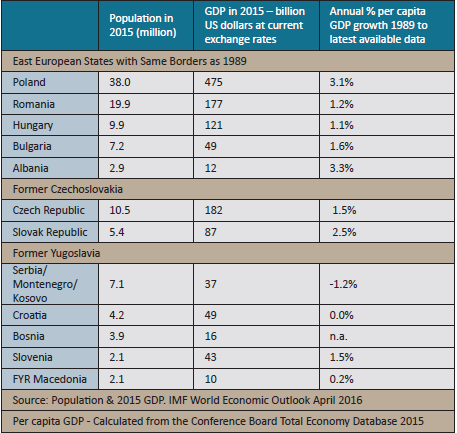China Strengthens Links with Central and Eastern Europe
By JOHN ROSS
THE recent period has seen a major increase in economic and diplomatic exchanges between China and Central and Eastern Europe. In March, Xi Jinping paid the first state visit by a Chinese President to the Czech Republic. In April Poland’s Foreign Minister Witold Waszczykowski visited Beijing and specifically underlined the importance of China’s Belt and Road Initiative. As Poland is the largest economy in Eastern Europe after Russia, the Polish government’s conclusions are worth quoting.

John Ross is a senior research fellow at Chongyang Institute for Financial Studies, Renmin University of China. From 2000 to 2008 he was director of economic and business policy in the administration of Mayor of London Ken Livingstone. He previously served as adviser to several major international mining, finance and equipment manufacturing companies.
Foreign Minister Waszczykowski remarked: “With regard to the economic aspect of EU-China contacts, I would single out the Chinese Belt and Road Initiative as the most promising platform for cooperation between Europe and the People’s Republic of China. Poland highly estimates this major initiative… The Belt and Road introduces a new quality into Europe-Asia relations. If the initiative succeeds, it will work out a new formula of a strategic relationship between our two continents…
“Poland is willing to take an active part in forging a synergy of initiatives within the Belt and Road, coupling them with EU projects implemented in the fields of infrastructure … I am convinced that the initiative ‘16+1’ [a coordination structure], which bridges the economies of 16 countries of Central and Eastern Europe and China, could contribute considerably to … the implementation of common projects.”
Slawomir Majman, president of the Polish Information and Foreign Investment Agency, similarly analyzed China and Poland’s major common opportunities: “China’s initiative to strengthen the economy along the Silk Road is very much in our interest, because Poland is interested in operating in the Euro-Asia region. We hope to be much more active in Pakistan, Azerbaijan, Turkmenistan and all countries along the Silk Road.” Consequently: “Why not develop arm-in-arm with Chinese partners?”
It is therefore worth considering what lies behind these recent developments, and taking a realistic look at both the potential and any possible problems in relations between China and Central and Eastern Europe.
After the dramatic political changes in Eastern Europe, Eastern and Central Europe experienced fragmentation. In 1989 there were eight former Communist countries in Eastern Europe and the former U.S.S.R. By 2015 there were 27 internationally recognized ones. The former U.S.S.R. went from one state to 15, Yugoslavia from one to five (six if the disputed status of Kosovo is included), and Czechoslovakia split in two.

The outcome has been Russia’s dominant economic weight among individual Eastern European states. Russia’s 2015 GDP of US $1,325 billion at current prices is 69 percent of the former USSR and five percent larger than the whole of the rest of Eastern Europe outside the former U.S.S.R. put together. Russia equally dominates logistical aspects of the Belt and Road Initiative. Goods can pass from China almost to the borders of Eastern Europe and vice versa exclusively on Russian territory. There are alternative routes via Central Asia but these involve several different states. The latter does not pose any great problems at present, with China having good relations with Central Asian states of the former U.S.S.R., but strategic planning must always take into account possible negative developments which could create uncertainty in the future. However, China’s relation with Russia firmly anchors the logistics for connecting China to Eastern Europe via the Belt and Road.
If Russia forms a firm land bridge for China with Eastern Europe, Poland is the key state in Eastern and Central Europe outside the former U.S.S.R. – having 34 percent of the population and 38 percent of the region’s GDP. This far exceeds any other state. Excluding Albania, whose population is less than three million, Poland also has had the region’s most rapid economic growth – greatly aided by budget transfers from the European Union. It is for this reason that the strong support given by Poland to the Belt and Road is so significant.
Given that geopolitical relations between Poland and Russia are at present not favourable, as Russia is logistically key to Belt and Road Initiative, and as geopolitical relations between China and Russia are good, this makes clear the great economic importance Poland attaches to its relations with China, and that Poland is not allowing any such complications to get in the way of economic cooperation.
The reason Central and Eastern European states are now paying major attention to China is clear. Immediately following 1989 their focus was almost exclusively on the EU in terms of hopes of membership and economic growth. But since the 2008 international financial crisis, growth in most of Western Europe within the EU has been slow. Taking a five-year average, to remove the effect of short-term fluctuations, recent average EU GDP growth has only been one percent, and in the Euro area only 0.6 percent. It has therefore become important for Central and Eastern European states to establish economic relations with more rapidly growing regions – and China is the world’s most dynamic major economy.
Equally for China the attractions of Central and Eastern Europe are evident. The IMF recently noted: “Economies in Central, Eastern and Southeastern Europe (CESEE) are poised to overtake the continent’s traditional economic powerhouses like Germany and France in terms of rate of growth … robust growth continued in most Central and Southeastern European economies … despite problems plaguing wider Europe such as deflation in the euro zone.” The IMF predicted Eastern and Central European growth this year at three to four percent compared to 1.6 percent for the euro area.
Firm economic fundamentals, therefore, underpin China and Eastern Europe’s recent mutual increase in contacts despite the considerable distances and any geopolitical complications involved.
